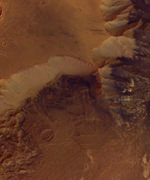In the latest of what will be ongoing briefings, Administrator Sean O’Keefe today announced a transformation of NASA’s organization structure designed to streamline the agency and position it to better implement the Vision for Space Exploration.
In a report released last week, the President’s Commission on Implementation of U.S. Space Exploration Policy found, “NASA needs to transform itself into a leaner, more focused agency by developing an organizational structure that recognizes the need for a more integrated approach to science requirements, management, and implementation of systems development and exploration missions.”
“Our task is to align Headquarters to eliminate the ‘stove pipes,’ promote synergy across the agency, and support the long-term exploration vision in a way that is sustainable and affordable,” said Administrator O’Keefe. “We need to take these critical steps to streamline the organization and create a structure that affixes clear authority and accountability.”
This transformation fundamentally restructures NASA’s Strategic Enterprises into Mission Directorates to better align with the Vision. It also restructures Headquarters support functions and clarifies organizational roles and responsibilities. The Mission Directorate organizational structure includes:
* Aeronautics Research: Research and develop aeronautical technologies for safe, reliable and efficient aviation systems
* Science: Carry out the scientific exploration of the Earth, Moon, Mars and beyond; chart the best route of discovery; and reap the benefits of Earth and space exploration for society. A combined organization is best able to establish an understanding of the Earth, other planets and their evolution, bring the lessons of our study of Earth to the exploration of the Solar System, and to assure the discoveries made here will enhance our work there
* Exploration Systems: Develops capabilities and supporting research and technology that enable sustained and affordable human and robotic exploration; includes the biological and physical research necessary to ensure the health and safety of crew during long duration space flight
* Space Operations: Direct space flight operations, space launches and space communications, as well as the operation of integrated systems in low-Earth orbit and beyond
Two agency-wide priorities will continue with direct responsibility for all related activities across NASA.
* Safety and Mission Assurance Officer: Reports directly to the Administrator and reflects NASA’s commitment to provide a clear and direct line to agency senior leadership for issues regarding safety
* Chief Education Officer: Directs the agency’s important work to improve scientific and technological literacy and inspire a new generation of explorers
NASA functional offices will be restructured as Mission Support Offices. Headquarters and field center offices will be aligned to improve communications and responsibility.
The major Mission Support Offices are:
* Chief Financial Officer (CFO): Conducts all financial matters, including procurement and small and disadvantaged business activities. All field center financial officers report directly to the Headquarters CFO to better address critical financial issues
* Associate Administrator for Institutions and Management: Responsible for providing operational and management support for Headquarters; directs a full range of activities relating to personnel and institutional management across the agency
* Chief Information Officer: Responsible for the development of an integrated focus on information resource management strategies, policies and practices
* Chief Engineer: Ensures the development efforts and missions operations are being planned and conducted on a sound engineering basis; assures independent technical authority within the agency’s engineering, operations and safety organizations
* Chief of Strategic Communications: Directs NASA’s communication efforts in Public Affairs, Legislative Affairs and External Relations; responsible for internal communications management
* General Counsel: Responsible for the legal aspects of all NASA’s activities; manages the agency’s intellectual property and ethics programs
To improve the decision-making process, NASA will create:
* Strategic Planning Council: Chaired by the NASA Administrator, the Council develops multi-year strategic plans, strategic roadmaps, and a multi-year detailed plan that forms the basis for policies and budgets
* Director of Advanced Planning: Responsible for the preparation of options, studies and assessments for the Strategic Planning Council
* Chief Operating Officer Council: Chaired by the Deputy Administrator, implements direction provided by the Strategic Planning Council and develops standard administrative practices to build on the President’s Management Agenda
The Associate Deputy Administrator for Systems Integration is responsible for strategic and systems integration across Mission Directorates and mission support functions
The agency will also redefine its relationships with the NASA Field Centers by developing clear and straightforward lines of responsibility and accountability. Specific Mission Associate Administrators will be assigned as Headquarters Center Executives. They will have oversight of field center performance in implementing agency policies and programs. The Associate Administrator for Institutions and Management will address field center infrastructure concerns.
The changes outlined today become effective August 1, 2004. They represent the next step in implementing the recommendations of the President’s Commission on Implementation of U.S. Space Exploration Policy and reflect NASA’s ongoing efforts to apply the findings and recommendations of the Columbia Accident Investigation Board across the agency.
Over the next several weeks, the Administrator will engage teams in each NASA location to provide front line guidance on implementing their early stages of the transformation plan. The discussions will be the precursor for a renewed commitment to mission success and excellence in an employee-centric organization.
“This transformation will be an evolutionary process, exploring new ways to move forward and implement change. We’ll also be engaging other government agencies, industry, academia and the international community to assist us in developing the tools and processes we need to successfully advance the Vision for Space Exploration,” added Administrator O’Keefe. “Doing so will enable us to take the next bold steps into space and rekindle the innovation and entrepreneurial skills that is our legacy to humankind.”
Additional presentation information and a new NASA organization chart is available on the Internet at:
Original Source: NASA News Release

